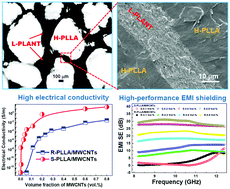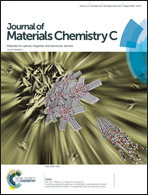Ultralow percolation threshold and enhanced electromagnetic interference shielding in poly(l-lactide)/multi-walled carbon nanotube nanocomposites with electrically conductive segregated networks†
Abstract
Electrically conductive segregated networks were built in poly(L-lactide)/multi-walled carbon nanotube (PLLA/MWCNT) nanocomposites without sacrificing their mechanical properties via simply choosing two different PLLA polymers with different viscosities and crystallinities. First, the MWCNTs were dispersed in PLLA with low viscosity and crystallinity (L-PLLA) to obtain the L-PLANT phase. Second, the PLLA particles with high viscosity and crystallinity (H-PLLA) were well coated with the L-PLANT phase at 140 °C which was below the melting temperature of H-PLLA. Finally, the coated H-PLLA particles were compressed above the melting temperature of H-PLLA to form the PLLA/MWCNT nanocomposites with segregated structures. The morphological observation showed the successful location of MWCNTs in the continuous L-PLLA phase, resulting in an ultralow percolation threshold of 0.019 vol% MWCNTs. The electrical conductivity and the electromagnetic interference (EMI) shielding effectiveness (SE) of the composites with the segregated structure are 25 S m−1 and ∼30 dB, showing three orders and 36% higher than that of the samples with a random distribution of MWCNTs with 0.8 vol% of MWCNT loading, respectively. High-performance electromagnetic interference (EMI) shielding was also observed mainly dependent on the highly efficient absorption shielding, which can be achieved by the densely continuous MWCNT networks and the abundant interfaces induced by the segregated structures. Furthermore, the composites with segregated structures not only showed higher Young's modulus and tensile strength than the corresponding conventional composites, but also maintained high elongation at break because of the continuous and dense MWCNT networks induced by the segregated structures and the high interfacial interaction between H-PLLA and L-PLLA.



 Please wait while we load your content...
Please wait while we load your content...